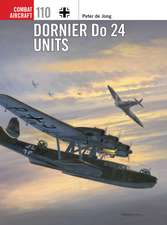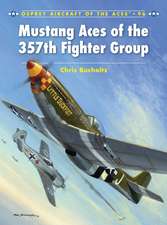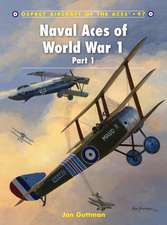Defiant, Blenheim and Havoc Aces: Aircraft of the Aces (Osprey), cartea 105
Autor Andrew Thomas Ilustrat de Chris Daveyen Limba Engleză Paperback – 5 iun 2012
Din seria Aircraft of the Aces (Osprey)
- 29%
 Preț: 92.40 lei
Preț: 92.40 lei - 29%
 Preț: 81.36 lei
Preț: 81.36 lei - 29%
 Preț: 81.36 lei
Preț: 81.36 lei - 30%
 Preț: 80.90 lei
Preț: 80.90 lei -
 Preț: 80.90 lei
Preț: 80.90 lei -
 Preț: 81.27 lei
Preț: 81.27 lei - 29%
 Preț: 81.19 lei
Preț: 81.19 lei -
 Preț: 81.19 lei
Preț: 81.19 lei -
 Preț: 80.29 lei
Preț: 80.29 lei -
 Preț: 80.99 lei
Preț: 80.99 lei -
 Preț: 80.99 lei
Preț: 80.99 lei -
 Preț: 80.90 lei
Preț: 80.90 lei -
 Preț: 80.90 lei
Preț: 80.90 lei -
 Preț: 80.99 lei
Preț: 80.99 lei - 29%
 Preț: 81.19 lei
Preț: 81.19 lei - 29%
 Preț: 81.19 lei
Preț: 81.19 lei - 30%
 Preț: 80.64 lei
Preț: 80.64 lei -
 Preț: 81.90 lei
Preț: 81.90 lei - 29%
 Preț: 81.62 lei
Preț: 81.62 lei - 29%
 Preț: 81.36 lei
Preț: 81.36 lei - 29%
 Preț: 81.09 lei
Preț: 81.09 lei - 30%
 Preț: 80.56 lei
Preț: 80.56 lei - 30%
 Preț: 80.56 lei
Preț: 80.56 lei -
 Preț: 80.99 lei
Preț: 80.99 lei - 30%
 Preț: 85.60 lei
Preț: 85.60 lei -
 Preț: 81.09 lei
Preț: 81.09 lei -
 Preț: 81.19 lei
Preț: 81.19 lei -
 Preț: 80.90 lei
Preț: 80.90 lei -
 Preț: 87.36 lei
Preț: 87.36 lei -
 Preț: 80.99 lei
Preț: 80.99 lei -
 Preț: 81.19 lei
Preț: 81.19 lei -
 Preț: 80.90 lei
Preț: 80.90 lei - 30%
 Preț: 80.99 lei
Preț: 80.99 lei -
 Preț: 80.99 lei
Preț: 80.99 lei -
 Preț: 80.99 lei
Preț: 80.99 lei -
 Preț: 80.90 lei
Preț: 80.90 lei - 30%
 Preț: 80.90 lei
Preț: 80.90 lei - 30%
 Preț: 80.73 lei
Preț: 80.73 lei -
 Preț: 80.99 lei
Preț: 80.99 lei
Preț: 81.19 lei
Preț vechi: 115.07 lei
-29% Nou
Puncte Express: 122
Preț estimativ în valută:
15.54€ • 16.25$ • 12.91£
15.54€ • 16.25$ • 12.91£
Carte tipărită la comandă
Livrare economică 03-17 aprilie
Preluare comenzi: 021 569.72.76
Specificații
ISBN-13: 9781849086660
ISBN-10: 1849086664
Pagini: 96
Ilustrații: Illustrations (some col.)
Dimensiuni: 183 x 246 x 8 mm
Greutate: 0.32 kg
Editura: Osprey Publishing (UK)
Seria Aircraft of the Aces (Osprey)
ISBN-10: 1849086664
Pagini: 96
Ilustrații: Illustrations (some col.)
Dimensiuni: 183 x 246 x 8 mm
Greutate: 0.32 kg
Editura: Osprey Publishing (UK)
Seria Aircraft of the Aces (Osprey)
Notă biografică
Andrew Thomas is one of Britain's leading RAF researchers, having published numerous articles and books on the subject, as well as readily assisting other authors. He joined the RAF to fly straight from school, and has maintained an enthusiastic interest in the history and development of his Service throughout his career. He has previously published a number of volumes in the renowned Osprey 'Aircraft of the Aces' series.
Recenzii
"This absorbing account begins with a bang ... And it gets better from there."
--David L. Veres, www.cybermodeler.com
"...provides a fine survey of some of the lesser-known fighter planes to serve with the RAF in World War II, and the pilots that flew them."
--James A. Cox, The Bookwatch (September 2012)
--David L. Veres, www.cybermodeler.com
"...provides a fine survey of some of the lesser-known fighter planes to serve with the RAF in World War II, and the pilots that flew them."
--James A. Cox, The Bookwatch (September 2012)
















